Ajinomoto Co., Inc., UMI, and Tokyo Institute of Technology Professors Establish New Company to implement the World's First On-Site Production of Ammonia
—Targeting low-cost, stable supply of amino acids and other fermentation materials, and their applications in agricultural fertilizers—
Ajinomoto Co., Inc. ("Ajinomoto Co.", Chuo-ku, Tokyo; President: Takaaki Nishii) and the No. 1 UMI Limited Partnership managed and operated by Universal Materials Incubator Co., Ltd. ("UMI"; Chuo-ku, Tokyo; Managing Director: Seiichi Tsukioka), Professor Hideo Hosono, Director of Materials Research Center for Element Strategy at Tokyo Institute of Technology, have established Tsubame BHB Co., Ltd. ("Tsubame BHB"), which strives to achieve practical applications for the world's first on-site ammonia synthesis systems, with the support of Japan Science and Technology Agency (JST), and using applying catalysts developed by Hosono's research group. The new company began operations on April 25, 2017.
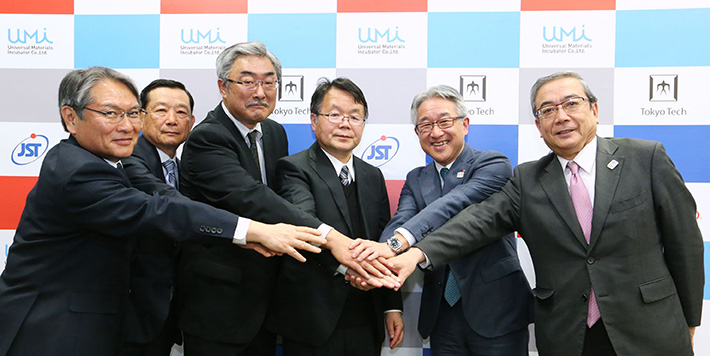
From left, JST Managing Director Goto, TsubameBHB CEO Nakatani, UMI president Tsukioka,
Professor Hosono, Ajinomoto President Nishii, President Mishima.
Amino acids and proteins are the building blocks of life. Each contains nitrogen1, an essential element for biological function. Ammonia is an important source of nitrogen, and over 160 million tons of ammonia are produced annually worldwide. Approximately 80% of this volume is used as raw material for fertilizers, and the remaining 20% is used for a variety of food products, pharmaceuticals, and chemical products.
Today, ammonia is mainly produced using the Haber-Bosch process, a method invented over 100 years ago. The Haber-Bosch process, which is used broadly throughout the world, is an outstanding production technology that enables synthesis of ammonia using only nitrogen from the air and hydrogen2 obtained mainly from natural gas. There are issues in the use of the Haber-Bosch process, however, in that reactions require high-temperature and high-pressure conditions, so concentrated, high-volume production must be undertaken at a single large-scale plant that consumes huge amounts of energy and entailing substantial capital investment. Furthermore, transporting ammonia from production sites to areas of demand throughout the world also necessitates specialized transport equipment and storage facilities, resulting in considerable logistics costs.
In response to these issues, Prof. Hosono and his group discovered and invented a catalyst that differs completely from catalysts used in the Haber-Bosch process, through the R&D Project "Materials Science and Application of Electrides" being undertaken as part of JST's Strategic Basic Research Programs (ACCEL)3. This catalyst enables highly efficient ammonia synthesis under low-temperature and low-pressure conditions. These low-temperature and low-pressure reaction conditions make it possible to produce ammonia even in small-scale plants, where production was considered difficult in the past. In the future, the practical application of these technologies is expected to form the foundation of a model for the world's first on-site ammonia production, through which ammonia can be produced where it is needed, and in the volumes required.
Ajinomoto Co. produces various types of amino acids, including glutamic acid, and other fermentation materials, by using large volumes of ammonia as a raw material, so the company has long been captivated by the revolutionary fundamental technologies discovered and invented by Prof. Hosono and his group to achieve the low-cost, stable supply of ammonia. As such, Ajinomoto Co. has been involved in joint development targeting the practical application of these technologies. In collaboration with Tsubame BHB, Ajinomoto Co. has been working toward achieving on-site ammonia production at its own plants, with the intention of using this as a driver to increase the cost competitiveness of its fermentation materials, and to contribute to coexistence with the Earth by reducing energy consumption and minimizing environmental impact from the production and transport of the fermentation sub raw material.
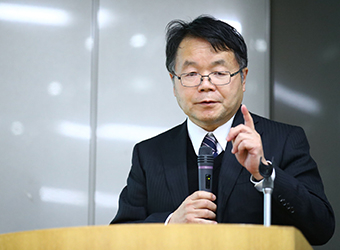 Hosono delivers a presentation.
Hosono delivers a presentation.Prof. Hosono of Tokyo Institute of Technology will serve as a technical advisor for Tsubame BHB, and support the development of applications for the new catalyst. In addition, joint research by Tokyo Institute of Technology and Tsubame BHB will further promote R&D targeting high-efficiency catalysts. JST and Tokyo Institute of Technology license patents for the new catalysts developed by Hosono's research group to Tsubame BHB as a foundation for on-site ammonia production technologies, and support Tsubame BHB's operations.
UMI will provide Tsubame BHB with the capital required to undertake its business operations in the future, and will also provide management support, for example by dispatching directors and other management staffs, and by strengthening the business development structure. Through these activities, UMI will strive to create success cases in the social implementation of promising academic seeds in the fields of materials and chemistry, and will contribute to the formation of ecosystems in these fields.
Tsubame BHB will introduce these technologies at Ajinomoto Co.'s fermentation material plants worldwide, and will aim to implement the world's first on-site ammonia production by around 2021. In the future, in collaboration with Ajinomoto Co. as well as a variety of partner companies, Tsubame BHB will strive to expand applications in areas such as agricultural fertilizers, food products, pharmaceuticals, and chemical products, contributing to society through the creation of sustainable, environment-friendly production systems.
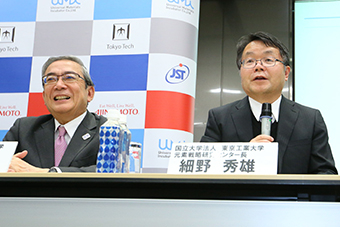
Hosono receives questions from reporters.(right)
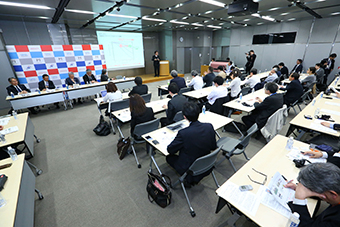
Press conference.
About Tsubame BHB Co., Ltd.
- Principal Office:
8-1 Akashi-cho, Chuo-ku, Tokyo
- R&D base:
4259 Nagatsuta-cho, Midori-ku, Yokohama City, Kanagawa
Tokyo Institute of Technology, Suzukakedai Campus
- Representative Director:
Hideo Nakatani
- Established:
April 5, 2017
- Start of business:
April 25, 2017
- Total investment:
JPY 450 million
- Capital structure:
No. 1 UMI Limited Partnership: 53%
Ajinomoto Co., Inc.: 44%
Prof. Hosono and others: 3%
- Outline of business:
R&D and manufacturing involving on-site ammonia production systems and catalysts
[Ref. 1] Outline of academic entities involved in the new technologies
Tokyo Institute of Technology
Tokyo Institute of Technology is a national university with a history spanning more than 130 years since its inception, and is considered Japan's top science and engineering university. It offers a creative approach to education with an emphasis on the spirit of Japanese "Monotsukuri" (production), and has turned out many outstanding Japanese leaders in the fields of industry and science. It fosters individuals who combine strong fundamental capabilities and scientific specialization with training in social sciences and the humanities, and who demonstrate communication skills that can be utilized effectively on the global stage.
Japan Science and Technology Agency
JST is a national R&D organization under the jurisdiction of the Ministry of Education, Culture, Sports, Science and Technology (MEXT). Its main goal is to promote science and technology in Japan through a wide range of activities including fundamental research, platform R&D, development of new technologies for industrialization, distribution of information, and putting in place platforms. As part of efforts to achieve rich and happy lifestyles for all citizens, it contributes to the creation of new value, and promotes science and technology to open up a new future for Japan.
[Ref. 2] Outline of investing companies
Ajinomoto Co., Inc.
- Head Office:
1-15-1 Kyobashi, Chuo-ku, Tokyo
- President:
Takaaki Nishii
- Founded:
May 20, 1909 (established December 17, 1925)
- Capital:
JPY 79,863 million (as of March 31, 2016)
- Sales:
JPY 1,185,980 million (year ended March 2016; consolidated base)
- Employees:
33,295 (as of March 31, 2016; consolidated base)
- Outline of business:
Manufacture and sales of condiments and processed foods, frozen foods, coffees, "Umami" seasonings and sweeteners for food processing, animal nutrients, chemical products, amino acids, and pharmaceuticals
No. 1 UMI Limited Partnership ("UMI Fund")
- Head Office:
8-1 Akashi-cho, Chuo-ku, Tokyo
- Administrative member:
Universal Materials Incubator Co., Ltd.
- Formed:
January 1, 2016
- Total investment:
JPY 10,010 million
- Goal of formation:
To invest in and foster venture companies in the materials and chemical industries
- Investors:
Innovation Network Corporation of Japan (INCJ); materials and chemical companies listed on the 1st Section of the Tokyo Stock Exchange (9 companies)
Universal Materials Incubator Co., Ltd. (UMI)
UMI invests in outstanding new technologies and businesses in the fields of materials and chemicals that form the foundations for future industry, originating from both Japanese companies and academia, based on the vision of "Strengthening Japan's engineering capabilities and cultivating an industry structure that can compete in the global arena, by fostering outstanding material/chemical companies."
Comment from professor Hosono
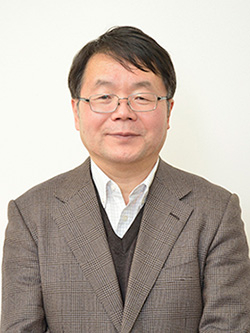
Professor Hideo Hosono
We started researching electrides in the JST ERATO project "Hosono Transparent ElectroActive Materials" (1999 - 2004). We focused on a cement mineral called 12CaO・7Al2O3 (C12A7), and, by exchanging oxygen ions which exist as counter anions within the cage forming the crystal structure with electrons, we realized for the first time an electride which is stable at room temperature (C12A7:e) in 2004. C12A7:e conducts electricity well, like a metal, and exhibits superconductivity at low temperatures. Further, it has unique physical properties of being chemically stable though its work function is as low as alkali metals. To utilize this property, we loaded ruthenium nanoparticles on C12A7:e and studied as a catalyst for ammonia synthesis under mild conditions and found that it has excellent performance. This series of outcomes is going to be included in one of the Chemistry textbooks for high schools which will be used starting the next school year.
Since being selected as the first project of JST's ACCEL program which was established in 2013, we have expanded the concept of electrides and developed many ammonia-synthesis catalysts. This outcome was noticed by Ajinomoto Co., Inc. and a sovereign wealth fund UMI, and a new company "Tsubame BHB" was set up. IGZO-TFTs we invented in 2003 contributed to a "better life" with beautiful and energy-saving flat panel displays, but this opportunity is for synthesizing amino acids essential for living. I am just delighted that we may be able to contribute to something "essential for life." I hope to somehow develop this together with collaborating researchers.
1 Nitrogen
Nitrogen gas makes up approximately 78% of the Earth's atmosphere. The element Nitrogen is essential to all life on Earth.
2 Hydrogen
Hydrogen, the most abundant element in the universe, has received attention in recent years as a source of clean energy; for example, as fuel for fuel cell vehicles.
3 Strategic Basic Research Programs (ACCEL)
As one of the projects conducted by JST, the goal of ACCEL is to identify outstanding research results that have the potential to be the world-leading, but where companies and other private entities might find it difficult to judge the risks. Program Managers lead R&D targeting new innovations, thereby supporting R&D activities by companies, venture startups, and other organizations. (Research Director: Hideo Hosono; Program Manager: Toshiharu Yokoyama)
- *
- This article has been updated to include photos and a document of the press conference on April 28.
- *
- This article has been updated to correct telephone number on May 1.
. Any information published on this site will be valid in relation to Science Tokyo.







